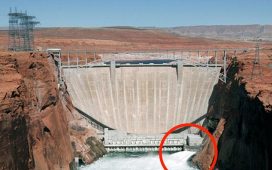Mercury dating back 252 million years has been discovered in rocks and adds to the growing belief that the ‘Great Dying’ was caused by volcanoes.
Researchers found strong mercury signals in rocks dating back to this time period when 95 per cent of all life was wiped out.
The signals were found in 10 different sites across the globe, and were dated by studying the teeth of fossilised eel-like creatures.
Causes of the so-called ‘Great Dying’ have been heavily debated but this study provides persuasive evidence that volcanic eruptions were to blame.
Scroll down for video

Rather than coming from vents in stereotypical cone-shaped volcanoes, the eruptions out of the Siberian Traps came mostly from huge fissures in the Earth’s crust (stock photo)
Known colloquially as ‘the Great Dying’, the mass extinction that took place 252 million years ago killed off a catastrophic 95 per cent of life on Earth.
The event is marked in the geological record as the boundary between the Permian and Triassic periods of time.
Rather than coming from vents in stereotypical cone-shaped volcanoes, the eruptions came out of huge fissures in the Earth’s crust.
‘Typically, when you have large, explosive volcanic eruptions, a lot of mercury is released into the atmosphere,’ explains paper author and geologist Thomas Algeo of the University of Cincinnati.
In addition, it is thought that the eruptions caused vast deposits of coal to ignite, releasing mercury vapour which travelled high up into the atmosphere.
Ultimately, this mercury rained back down onto the earth, leaving behind an environmental signature in marine sediments across the globe.
It is this signature that the researchers have detected in 10 sites across the globe.
The study sites were chosen to represent various marine environments, including shallow and deep settings, both near and far from the eruption site.
The catastrophe notably ravaged the living amphibian and reptile species of the time, and is thought to have created the environmental space that would ultimately allow new groups — including the dinosaurs — to evolve.
Both land-based and marine species were hit by the catastrophe.
It has long been argued that the mass extinction was triggered as a result of massive volcanic activity in the so-called Siberian Traps.
The Traps are located in what today has become central Russia.
In total, the Siberian Traps are thought to have pumped up to 0.7 million cubic miles (3 million cubic kilometres) of ash into the atmosphere during the volcanic activity.
As a comparison, the violent eruption of Mount St Helens in Washington, US, in 1980 sent only 0.2 cubic miles (1 cubic kilometre) of ash into the atmosphere.
This is even though ash from the mountain was recorded as falling as far away as Oklahoma, 2,000 miles (3,218 kilometres) distant.
‘Mercury is a relatively new indicator for researchers. It has become a hot topic for investigating volcanic influences on major events in Earth’s history,’ said Professor Algeo.

The researchers used the sharp, fossilised teeth of creatures called conodonts (pictured, stock image) to date the rocks in which they found mercury deposited
Professor Algeo teamed up with colleagues from both Cincinnati and the China University of Geosciences,
The researchers used the sharp, fossilised teeth of creatures called conodonts – which resemble eels – to date the rocks in which they found mercury deposited.
Like the majority of creatures living on the planet 252 million years ago, conodonts were heavily impacted by the Permian–Triassic extinction event.
However, they survived for about another 52 million years.

Like the majority of creatures living on the planet 252 million years ago, conodonts were heavily impacted by the Permian–Triassic extinction event. However, they survived for about another 52 million years. (Pictured: an artist’s impression of a conodont, Promissum pulchrum, that lived about 232 million years before the Great Dying)
According to Professor Algeo, the volume of material the Traps released — especially greenhouse gases — would have warmed the planet by an average of 18°F (10°C).
This climatic shift would have been a major force in the mass extinction.
‘We’re often left scratching our heads about what exactly was most harmful,’ explained Professor Algeo.
‘Creatures adapted to colder environments would have been out of luck. So, my guess is temperature change would be the No. 1 killer,’ he added.
Alongside this, acid rain would have spoiled bodies of water, alongside raising the acidity of global oceans.
The warmer water would also not have been able to contain as much dissolved oxygen, creating dead zones that were inhospitable to life.
The sheer duration of the volcanic eruptions from the traps would have made it even harder for life to cope with the environmental changes.
‘It’s not necessarily the intensity but the duration that matters. The longer this went on, the more pressure was placed on the environment,’ Professor Algeo said.
Researchers are now trying to determine the scale of the eruptions from the Siberian Traps, alongside which of the resulting environmental effects were most devastating.
Knowledge gained here could be vital in the present day.
‘The release of carbon into the atmosphere by human beings is similar to the situation in the Late Permian, where abundant carbon was released by the Siberian eruptions,” said paper author Jun Shen, who is a researcher at the China University of Geosciences, in Wuhan.
This, Professor Algeo agrees, is cause for concern.
‘A majority of biologists believe we’re at the cusp of another mass extinction — the sixth big one,’ he added.
‘What we should learn is this will be serious business that will harm human interests, so we should work to minimise the damage.’
People living in marginal environments such as arid deserts will suffer first. This will lead to more climate refugees around the world.
‘We’re likely to see more famine and mass migration in the hardest hit places,’ Professor Algeo adds.
‘It’s a global issue and one we should recognise and proactively deal with; it’s much easier to address these problems before they reach a crisis.’
The Permian—Triassic extinction is not the only such catastrophe which researchers have studied using elemental signatures.
The mass extinction that killed the dinosaurs 65 million years ago is associated with a global signature of concentrated iridium – an element which is rare on the Earth.
Scientists believe that the iridium came instead from enormous meteor striking the planet off of the Gulf of Mexico.
Iridium dust would have been blown across the globe, forming a thin layer which can be found preserved in rocks today.
The full findings of the study were published in the journal Nature Communications.














